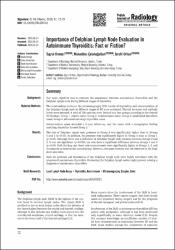| dc.contributor.author | Örmeci, Tuğrul | |
| dc.contributor.author | Çolakoğulları, Mukaddes | |
| dc.contributor.author | Orhan, İsrafil | |
| dc.date.accessioned | 10.07.201910:49:13 | |
| dc.date.accessioned | 2019-07-10T20:02:38Z | |
| dc.date.available | 10.07.201910:49:13 | |
| dc.date.available | 2019-07-10T20:02:38Z | |
| dc.date.issued | 2016 | en_US |
| dc.identifier.citation | Örmeci, T., Çolakoğulları, M. ve Orhan, İ. (2016). Importance of delphian lymph node evaluation in autoimmune thyroiditis: Fact or fiction? Polish Journal Of Radiology, 81, 72-79. https://dx.doi.org/10.12659/PJR.895761 | en_US |
| dc.identifier.issn | 0137-7183 | |
| dc.identifier.issn | 1899-0967 | |
| dc.identifier.uri | https://dx.doi.org/10.12659/PJR.895761 | |
| dc.identifier.uri | https://hdl.handle.net/20.500.12511/3697 | |
| dc.description | WOS: 000386237700001 | en_US |
| dc.description | PubMed ID: 26985243 | en_US |
| dc.description.abstract | Background: Our main objective was to evaluate the association between autoimmune thyroiditis and the Delphian lymph node during different stages of thyroiditis. Material/Methods: The relationships between the ultrasonography (US) results of thyroiditis and characteristics of the Delphian lymph node in different stages of AT were evaluated. Thyroid hormone and antibody levels were assessed. A total of 126 patients were divided into four groups according to the thyroid US findings: Group 1: control cases; Group 2: indeterminate cases; Group 3: established thyroiditis cases; Group 4: advanced-late stage thyroiditis cases. Indeterminate cases attended a 1-year follow-up, and the cases with a sonographic finding matching thyroiditis formed Group 2. Results: The rate of Delphian lymph node presence in Group 4 was significantly higher than in Groups 1 and 2 (p<0.01). In addition, its presence was significantly higher in Group 3 than in Group 1 (p<0.05). Although there was a difference in Delphian lymph node presence between Groups 2 and 3, it was not significant (p=0.052), nor was there a significant difference between Groups 1 and 2 (p>0.05). Both the long and short axis measurements were significantly higher in Groups 2, 3, and 4 compared to those in the control group. However, the same increase was not observed in the long/short axis ratio. Conclusions: Both the presence and dimensions of the Delphian lymph node were highly correlated with the progress of autoimmune thyroiditis. Evaluating the Delphian lymph nodes might prevent missing a diagnosis of autoimmune thyroiditis. | en_US |
| dc.language.iso | eng | en_US |
| dc.publisher | Int Scientific Information Inc | en_US |
| dc.rights | info:eu-repo/semantics/openAccess | en_US |
| dc.subject | Local Lymph Node Assay | en_US |
| dc.subject | Thyroiditis Autoimmune | en_US |
| dc.subject | Ultrasonography Doppler Color | en_US |
| dc.title | Importance of delphian lymph node evaluation in autoimmune thyroiditis: Fact or fiction? | en_US |
| dc.type | article | en_US |
| dc.relation.ispartof | Polish Journal Of Radiology | en_US |
| dc.department | İstanbul Medipol Üniversitesi, Tıp Fakültesi, Dahili Tıp Bilimleri Bölümü, Radyoloji Ana Bilim Dalı | en_US |
| dc.department | İstanbul Medipol Üniversitesi, Tıp Fakültesi, Temel Tıp Bilimleri Bölümü, Tıbbi Biyokimya Ana Bilim Dalı | en_US |
| dc.identifier.volume | 81 | en_US |
| dc.identifier.startpage | 72 | en_US |
| dc.identifier.endpage | 79 | en_US |
| dc.relation.publicationcategory | Makale - Uluslararası Hakemli Dergi - Kurum Öğretim Elemanı | en_US |
| dc.identifier.doi | 10.12659/PJR.895761 | en_US |
| dc.identifier.scopusquality | Q3 | en_US |


















